EDU30005 Case Study: Actions for Inclusive Education & Support
VerifiedAdded on 2023/06/14
|9
|2656
|120
Case Study
AI Summary
This case study examines the creation of an inclusive learning environment for children with diverse needs, focusing on the actions a teacher should take. It analyzes the profiles of five children—Tara (deafness), Joseph (ADHD), Lucy (cerebral palsy), Faite (emotional distress), and Mishka (sensory processing disorder)—highlighting the importance of addressing their individual requirements. The discussion covers the definition of inclusion, the capacity to include children with special needs, and strategies for providing an inclusive environment. Recommendations include consulting specialists, creating individual student profiles, using assistive technologies, modifying curriculum evaluation, and providing physical and emotional support. The report emphasizes collaboration between teachers and students to foster respect, academic excellence, and thoughtfulness, ultimately promoting a supportive and inclusive classroom for all children.
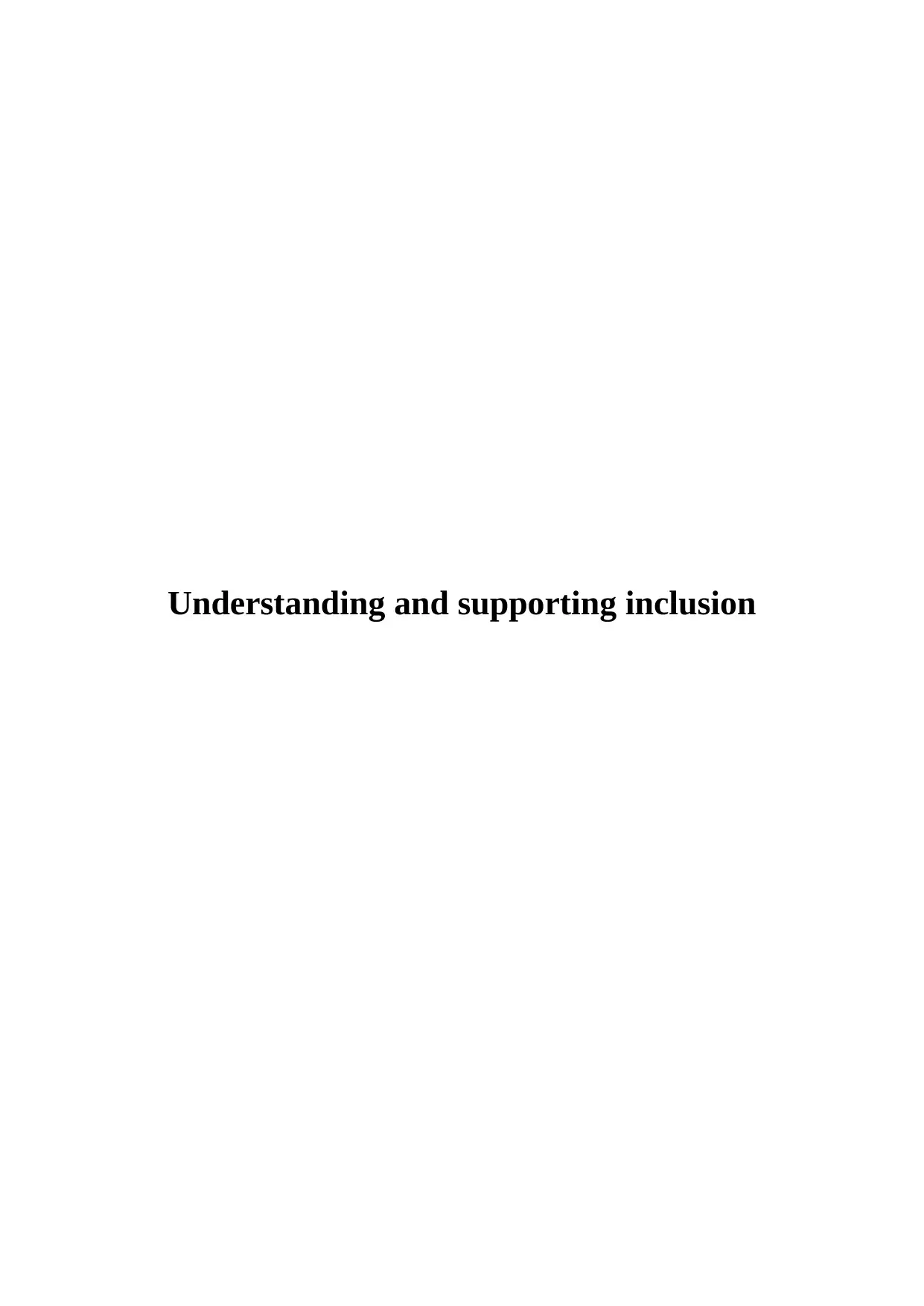
Understanding and supporting inclusion
Paraphrase This Document
Need a fresh take? Get an instant paraphrase of this document with our AI Paraphraser
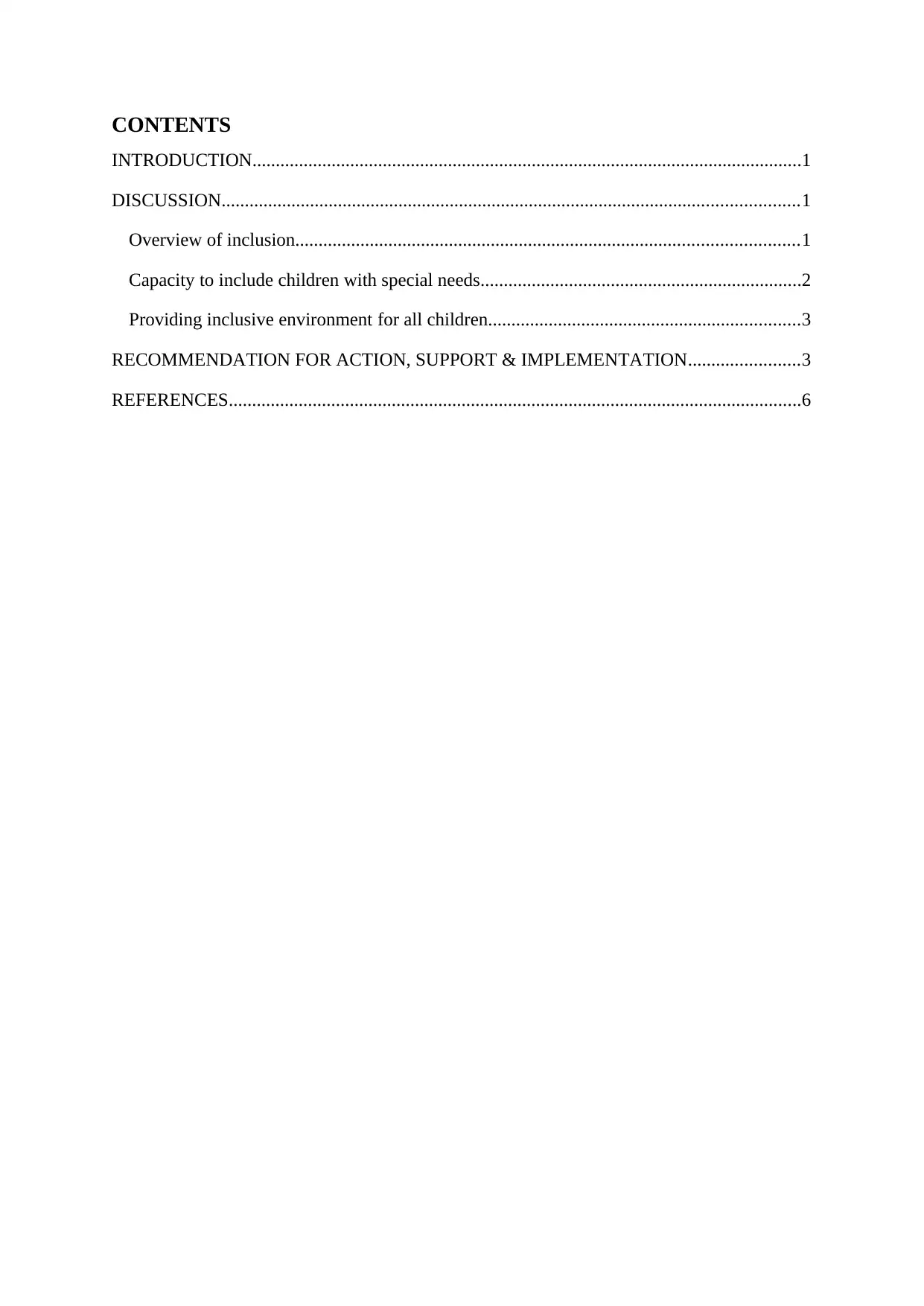
CONTENTS
INTRODUCTION......................................................................................................................1
DISCUSSION............................................................................................................................1
Overview of inclusion............................................................................................................1
Capacity to include children with special needs.....................................................................2
Providing inclusive environment for all children...................................................................3
RECOMMENDATION FOR ACTION, SUPPORT & IMPLEMENTATION........................3
REFERENCES...........................................................................................................................6
INTRODUCTION......................................................................................................................1
DISCUSSION............................................................................................................................1
Overview of inclusion............................................................................................................1
Capacity to include children with special needs.....................................................................2
Providing inclusive environment for all children...................................................................3
RECOMMENDATION FOR ACTION, SUPPORT & IMPLEMENTATION........................3
REFERENCES...........................................................................................................................6
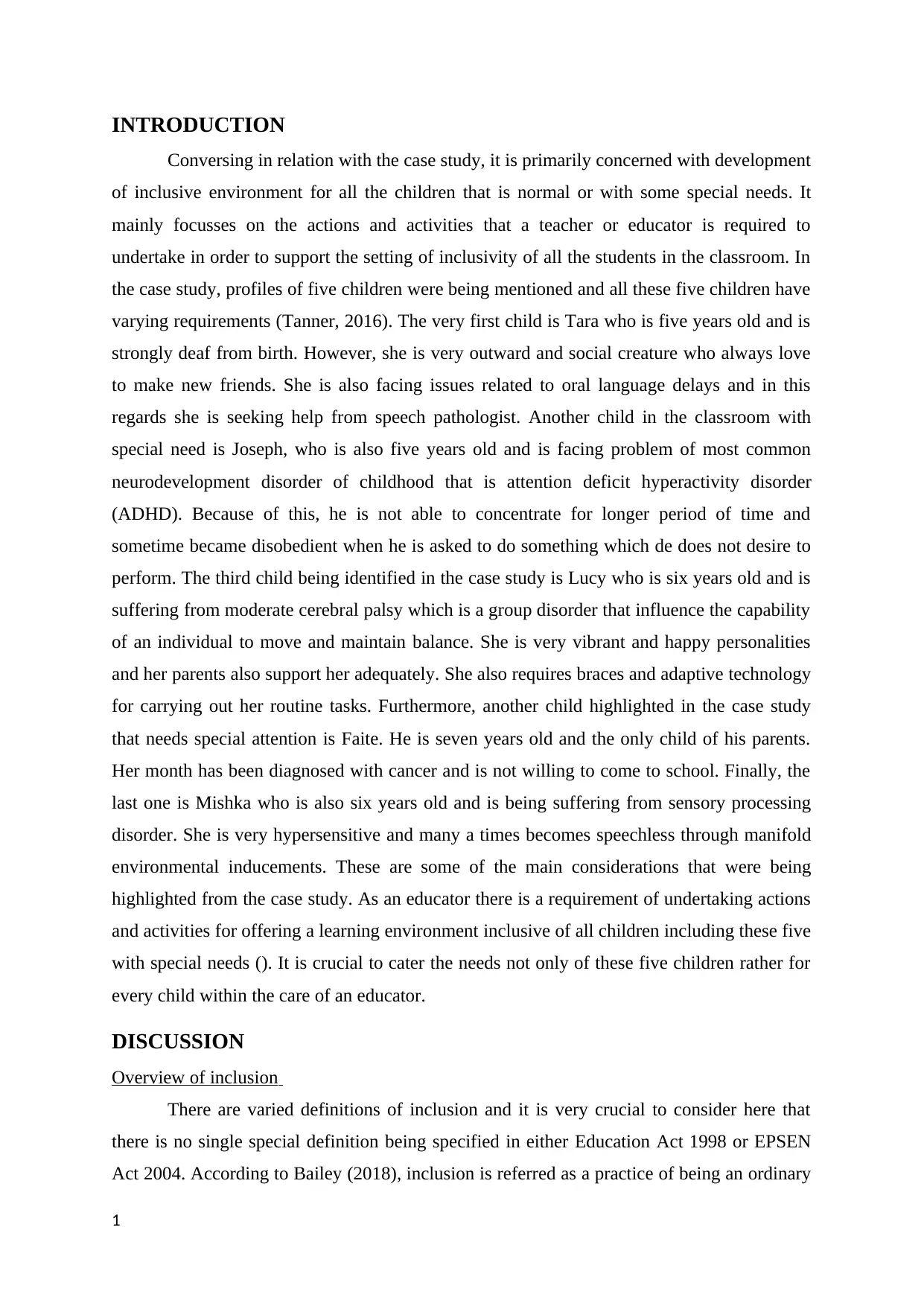
INTRODUCTION
Conversing in relation with the case study, it is primarily concerned with development
of inclusive environment for all the children that is normal or with some special needs. It
mainly focusses on the actions and activities that a teacher or educator is required to
undertake in order to support the setting of inclusivity of all the students in the classroom. In
the case study, profiles of five children were being mentioned and all these five children have
varying requirements (Tanner, 2016). The very first child is Tara who is five years old and is
strongly deaf from birth. However, she is very outward and social creature who always love
to make new friends. She is also facing issues related to oral language delays and in this
regards she is seeking help from speech pathologist. Another child in the classroom with
special need is Joseph, who is also five years old and is facing problem of most common
neurodevelopment disorder of childhood that is attention deficit hyperactivity disorder
(ADHD). Because of this, he is not able to concentrate for longer period of time and
sometime became disobedient when he is asked to do something which de does not desire to
perform. The third child being identified in the case study is Lucy who is six years old and is
suffering from moderate cerebral palsy which is a group disorder that influence the capability
of an individual to move and maintain balance. She is very vibrant and happy personalities
and her parents also support her adequately. She also requires braces and adaptive technology
for carrying out her routine tasks. Furthermore, another child highlighted in the case study
that needs special attention is Faite. He is seven years old and the only child of his parents.
Her month has been diagnosed with cancer and is not willing to come to school. Finally, the
last one is Mishka who is also six years old and is being suffering from sensory processing
disorder. She is very hypersensitive and many a times becomes speechless through manifold
environmental inducements. These are some of the main considerations that were being
highlighted from the case study. As an educator there is a requirement of undertaking actions
and activities for offering a learning environment inclusive of all children including these five
with special needs (). It is crucial to cater the needs not only of these five children rather for
every child within the care of an educator.
DISCUSSION
Overview of inclusion
There are varied definitions of inclusion and it is very crucial to consider here that
there is no single special definition being specified in either Education Act 1998 or EPSEN
Act 2004. According to Bailey (2018), inclusion is referred as a practice of being an ordinary
1
Conversing in relation with the case study, it is primarily concerned with development
of inclusive environment for all the children that is normal or with some special needs. It
mainly focusses on the actions and activities that a teacher or educator is required to
undertake in order to support the setting of inclusivity of all the students in the classroom. In
the case study, profiles of five children were being mentioned and all these five children have
varying requirements (Tanner, 2016). The very first child is Tara who is five years old and is
strongly deaf from birth. However, she is very outward and social creature who always love
to make new friends. She is also facing issues related to oral language delays and in this
regards she is seeking help from speech pathologist. Another child in the classroom with
special need is Joseph, who is also five years old and is facing problem of most common
neurodevelopment disorder of childhood that is attention deficit hyperactivity disorder
(ADHD). Because of this, he is not able to concentrate for longer period of time and
sometime became disobedient when he is asked to do something which de does not desire to
perform. The third child being identified in the case study is Lucy who is six years old and is
suffering from moderate cerebral palsy which is a group disorder that influence the capability
of an individual to move and maintain balance. She is very vibrant and happy personalities
and her parents also support her adequately. She also requires braces and adaptive technology
for carrying out her routine tasks. Furthermore, another child highlighted in the case study
that needs special attention is Faite. He is seven years old and the only child of his parents.
Her month has been diagnosed with cancer and is not willing to come to school. Finally, the
last one is Mishka who is also six years old and is being suffering from sensory processing
disorder. She is very hypersensitive and many a times becomes speechless through manifold
environmental inducements. These are some of the main considerations that were being
highlighted from the case study. As an educator there is a requirement of undertaking actions
and activities for offering a learning environment inclusive of all children including these five
with special needs (). It is crucial to cater the needs not only of these five children rather for
every child within the care of an educator.
DISCUSSION
Overview of inclusion
There are varied definitions of inclusion and it is very crucial to consider here that
there is no single special definition being specified in either Education Act 1998 or EPSEN
Act 2004. According to Bailey (2018), inclusion is referred as a practice of being an ordinary
1
⊘ This is a preview!⊘
Do you want full access?
Subscribe today to unlock all pages.

Trusted by 1+ million students worldwide
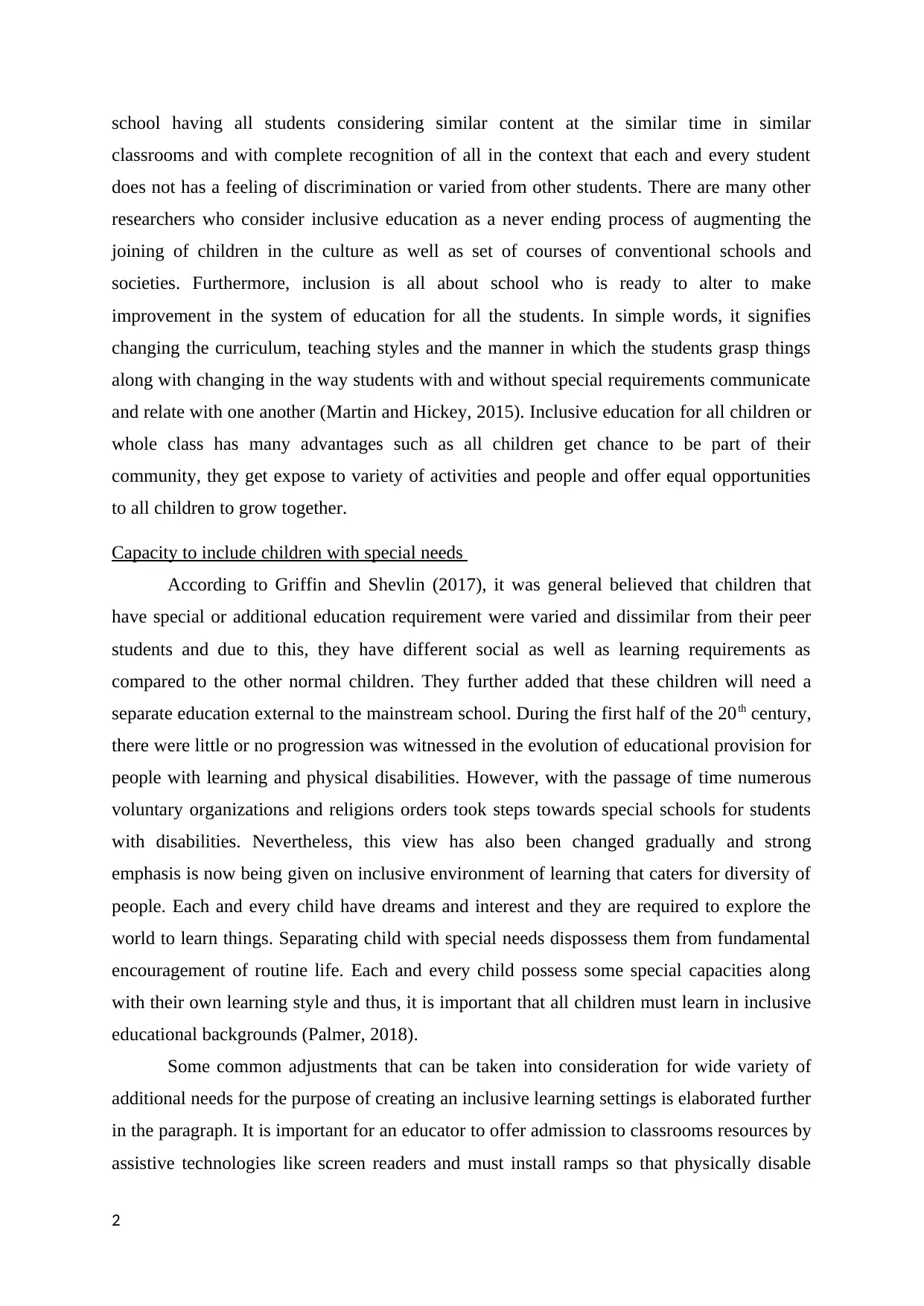
school having all students considering similar content at the similar time in similar
classrooms and with complete recognition of all in the context that each and every student
does not has a feeling of discrimination or varied from other students. There are many other
researchers who consider inclusive education as a never ending process of augmenting the
joining of children in the culture as well as set of courses of conventional schools and
societies. Furthermore, inclusion is all about school who is ready to alter to make
improvement in the system of education for all the students. In simple words, it signifies
changing the curriculum, teaching styles and the manner in which the students grasp things
along with changing in the way students with and without special requirements communicate
and relate with one another (Martin and Hickey, 2015). Inclusive education for all children or
whole class has many advantages such as all children get chance to be part of their
community, they get expose to variety of activities and people and offer equal opportunities
to all children to grow together.
Capacity to include children with special needs
According to Griffin and Shevlin (2017), it was general believed that children that
have special or additional education requirement were varied and dissimilar from their peer
students and due to this, they have different social as well as learning requirements as
compared to the other normal children. They further added that these children will need a
separate education external to the mainstream school. During the first half of the 20th century,
there were little or no progression was witnessed in the evolution of educational provision for
people with learning and physical disabilities. However, with the passage of time numerous
voluntary organizations and religions orders took steps towards special schools for students
with disabilities. Nevertheless, this view has also been changed gradually and strong
emphasis is now being given on inclusive environment of learning that caters for diversity of
people. Each and every child have dreams and interest and they are required to explore the
world to learn things. Separating child with special needs dispossess them from fundamental
encouragement of routine life. Each and every child possess some special capacities along
with their own learning style and thus, it is important that all children must learn in inclusive
educational backgrounds (Palmer, 2018).
Some common adjustments that can be taken into consideration for wide variety of
additional needs for the purpose of creating an inclusive learning settings is elaborated further
in the paragraph. It is important for an educator to offer admission to classrooms resources by
assistive technologies like screen readers and must install ramps so that physically disable
2
classrooms and with complete recognition of all in the context that each and every student
does not has a feeling of discrimination or varied from other students. There are many other
researchers who consider inclusive education as a never ending process of augmenting the
joining of children in the culture as well as set of courses of conventional schools and
societies. Furthermore, inclusion is all about school who is ready to alter to make
improvement in the system of education for all the students. In simple words, it signifies
changing the curriculum, teaching styles and the manner in which the students grasp things
along with changing in the way students with and without special requirements communicate
and relate with one another (Martin and Hickey, 2015). Inclusive education for all children or
whole class has many advantages such as all children get chance to be part of their
community, they get expose to variety of activities and people and offer equal opportunities
to all children to grow together.
Capacity to include children with special needs
According to Griffin and Shevlin (2017), it was general believed that children that
have special or additional education requirement were varied and dissimilar from their peer
students and due to this, they have different social as well as learning requirements as
compared to the other normal children. They further added that these children will need a
separate education external to the mainstream school. During the first half of the 20th century,
there were little or no progression was witnessed in the evolution of educational provision for
people with learning and physical disabilities. However, with the passage of time numerous
voluntary organizations and religions orders took steps towards special schools for students
with disabilities. Nevertheless, this view has also been changed gradually and strong
emphasis is now being given on inclusive environment of learning that caters for diversity of
people. Each and every child have dreams and interest and they are required to explore the
world to learn things. Separating child with special needs dispossess them from fundamental
encouragement of routine life. Each and every child possess some special capacities along
with their own learning style and thus, it is important that all children must learn in inclusive
educational backgrounds (Palmer, 2018).
Some common adjustments that can be taken into consideration for wide variety of
additional needs for the purpose of creating an inclusive learning settings is elaborated further
in the paragraph. It is important for an educator to offer admission to classrooms resources by
assistive technologies like screen readers and must install ramps so that physically disable
2
Paraphrase This Document
Need a fresh take? Get an instant paraphrase of this document with our AI Paraphraser
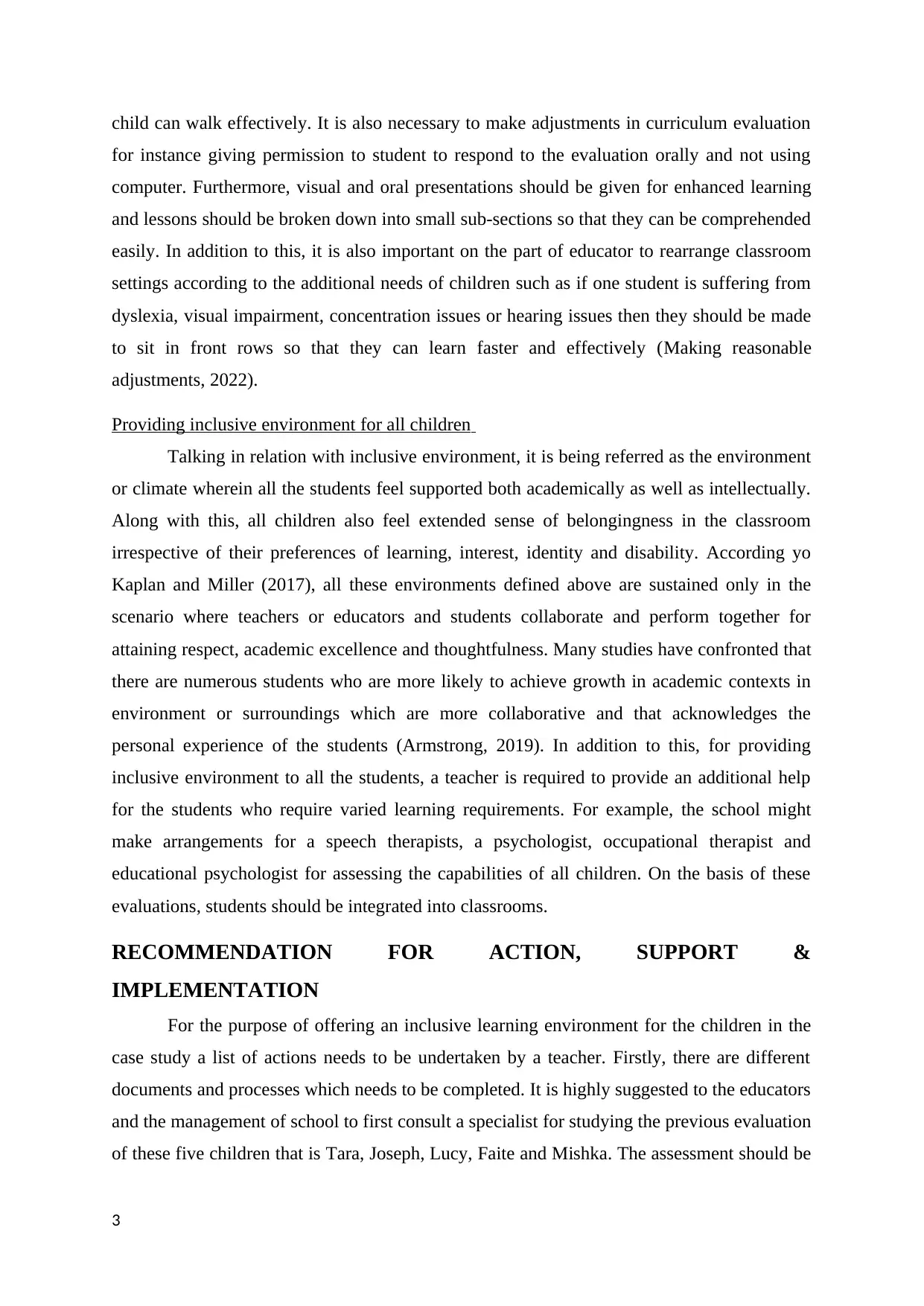
child can walk effectively. It is also necessary to make adjustments in curriculum evaluation
for instance giving permission to student to respond to the evaluation orally and not using
computer. Furthermore, visual and oral presentations should be given for enhanced learning
and lessons should be broken down into small sub-sections so that they can be comprehended
easily. In addition to this, it is also important on the part of educator to rearrange classroom
settings according to the additional needs of children such as if one student is suffering from
dyslexia, visual impairment, concentration issues or hearing issues then they should be made
to sit in front rows so that they can learn faster and effectively (Making reasonable
adjustments, 2022).
Providing inclusive environment for all children
Talking in relation with inclusive environment, it is being referred as the environment
or climate wherein all the students feel supported both academically as well as intellectually.
Along with this, all children also feel extended sense of belongingness in the classroom
irrespective of their preferences of learning, interest, identity and disability. According yo
Kaplan and Miller (2017), all these environments defined above are sustained only in the
scenario where teachers or educators and students collaborate and perform together for
attaining respect, academic excellence and thoughtfulness. Many studies have confronted that
there are numerous students who are more likely to achieve growth in academic contexts in
environment or surroundings which are more collaborative and that acknowledges the
personal experience of the students (Armstrong, 2019). In addition to this, for providing
inclusive environment to all the students, a teacher is required to provide an additional help
for the students who require varied learning requirements. For example, the school might
make arrangements for a speech therapists, a psychologist, occupational therapist and
educational psychologist for assessing the capabilities of all children. On the basis of these
evaluations, students should be integrated into classrooms.
RECOMMENDATION FOR ACTION, SUPPORT &
IMPLEMENTATION
For the purpose of offering an inclusive learning environment for the children in the
case study a list of actions needs to be undertaken by a teacher. Firstly, there are different
documents and processes which needs to be completed. It is highly suggested to the educators
and the management of school to first consult a specialist for studying the previous evaluation
of these five children that is Tara, Joseph, Lucy, Faite and Mishka. The assessment should be
3
for instance giving permission to student to respond to the evaluation orally and not using
computer. Furthermore, visual and oral presentations should be given for enhanced learning
and lessons should be broken down into small sub-sections so that they can be comprehended
easily. In addition to this, it is also important on the part of educator to rearrange classroom
settings according to the additional needs of children such as if one student is suffering from
dyslexia, visual impairment, concentration issues or hearing issues then they should be made
to sit in front rows so that they can learn faster and effectively (Making reasonable
adjustments, 2022).
Providing inclusive environment for all children
Talking in relation with inclusive environment, it is being referred as the environment
or climate wherein all the students feel supported both academically as well as intellectually.
Along with this, all children also feel extended sense of belongingness in the classroom
irrespective of their preferences of learning, interest, identity and disability. According yo
Kaplan and Miller (2017), all these environments defined above are sustained only in the
scenario where teachers or educators and students collaborate and perform together for
attaining respect, academic excellence and thoughtfulness. Many studies have confronted that
there are numerous students who are more likely to achieve growth in academic contexts in
environment or surroundings which are more collaborative and that acknowledges the
personal experience of the students (Armstrong, 2019). In addition to this, for providing
inclusive environment to all the students, a teacher is required to provide an additional help
for the students who require varied learning requirements. For example, the school might
make arrangements for a speech therapists, a psychologist, occupational therapist and
educational psychologist for assessing the capabilities of all children. On the basis of these
evaluations, students should be integrated into classrooms.
RECOMMENDATION FOR ACTION, SUPPORT &
IMPLEMENTATION
For the purpose of offering an inclusive learning environment for the children in the
case study a list of actions needs to be undertaken by a teacher. Firstly, there are different
documents and processes which needs to be completed. It is highly suggested to the educators
and the management of school to first consult a specialist for studying the previous evaluation
of these five children that is Tara, Joseph, Lucy, Faite and Mishka. The assessment should be
3
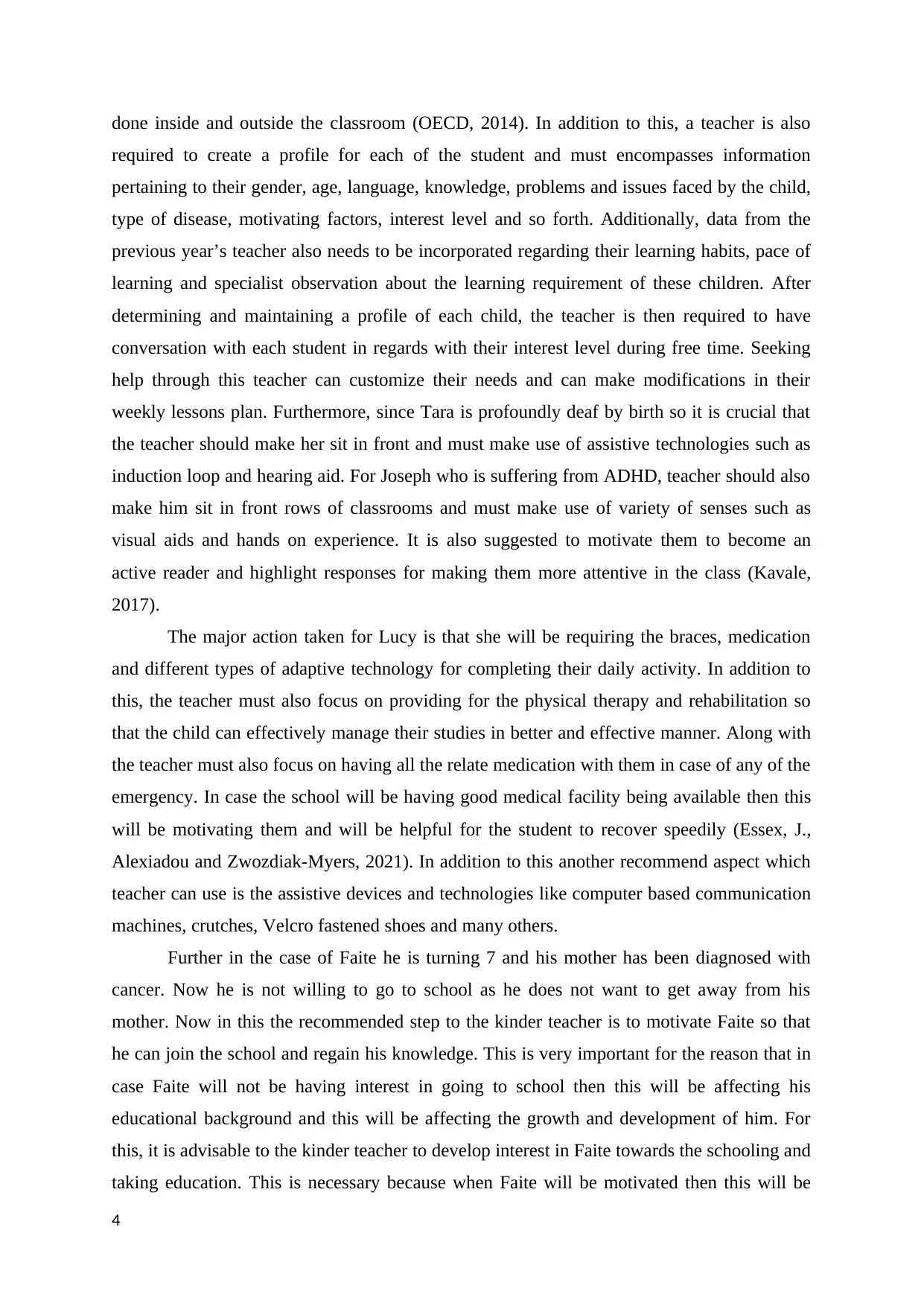
done inside and outside the classroom (OECD, 2014). In addition to this, a teacher is also
required to create a profile for each of the student and must encompasses information
pertaining to their gender, age, language, knowledge, problems and issues faced by the child,
type of disease, motivating factors, interest level and so forth. Additionally, data from the
previous year’s teacher also needs to be incorporated regarding their learning habits, pace of
learning and specialist observation about the learning requirement of these children. After
determining and maintaining a profile of each child, the teacher is then required to have
conversation with each student in regards with their interest level during free time. Seeking
help through this teacher can customize their needs and can make modifications in their
weekly lessons plan. Furthermore, since Tara is profoundly deaf by birth so it is crucial that
the teacher should make her sit in front and must make use of assistive technologies such as
induction loop and hearing aid. For Joseph who is suffering from ADHD, teacher should also
make him sit in front rows of classrooms and must make use of variety of senses such as
visual aids and hands on experience. It is also suggested to motivate them to become an
active reader and highlight responses for making them more attentive in the class (Kavale,
2017).
The major action taken for Lucy is that she will be requiring the braces, medication
and different types of adaptive technology for completing their daily activity. In addition to
this, the teacher must also focus on providing for the physical therapy and rehabilitation so
that the child can effectively manage their studies in better and effective manner. Along with
the teacher must also focus on having all the relate medication with them in case of any of the
emergency. In case the school will be having good medical facility being available then this
will be motivating them and will be helpful for the student to recover speedily (Essex, J.,
Alexiadou and Zwozdiak-Myers, 2021). In addition to this another recommend aspect which
teacher can use is the assistive devices and technologies like computer based communication
machines, crutches, Velcro fastened shoes and many others.
Further in the case of Faite he is turning 7 and his mother has been diagnosed with
cancer. Now he is not willing to go to school as he does not want to get away from his
mother. Now in this the recommended step to the kinder teacher is to motivate Faite so that
he can join the school and regain his knowledge. This is very important for the reason that in
case Faite will not be having interest in going to school then this will be affecting his
educational background and this will be affecting the growth and development of him. For
this, it is advisable to the kinder teacher to develop interest in Faite towards the schooling and
taking education. This is necessary because when Faite will be motivated then this will be
4
required to create a profile for each of the student and must encompasses information
pertaining to their gender, age, language, knowledge, problems and issues faced by the child,
type of disease, motivating factors, interest level and so forth. Additionally, data from the
previous year’s teacher also needs to be incorporated regarding their learning habits, pace of
learning and specialist observation about the learning requirement of these children. After
determining and maintaining a profile of each child, the teacher is then required to have
conversation with each student in regards with their interest level during free time. Seeking
help through this teacher can customize their needs and can make modifications in their
weekly lessons plan. Furthermore, since Tara is profoundly deaf by birth so it is crucial that
the teacher should make her sit in front and must make use of assistive technologies such as
induction loop and hearing aid. For Joseph who is suffering from ADHD, teacher should also
make him sit in front rows of classrooms and must make use of variety of senses such as
visual aids and hands on experience. It is also suggested to motivate them to become an
active reader and highlight responses for making them more attentive in the class (Kavale,
2017).
The major action taken for Lucy is that she will be requiring the braces, medication
and different types of adaptive technology for completing their daily activity. In addition to
this, the teacher must also focus on providing for the physical therapy and rehabilitation so
that the child can effectively manage their studies in better and effective manner. Along with
the teacher must also focus on having all the relate medication with them in case of any of the
emergency. In case the school will be having good medical facility being available then this
will be motivating them and will be helpful for the student to recover speedily (Essex, J.,
Alexiadou and Zwozdiak-Myers, 2021). In addition to this another recommend aspect which
teacher can use is the assistive devices and technologies like computer based communication
machines, crutches, Velcro fastened shoes and many others.
Further in the case of Faite he is turning 7 and his mother has been diagnosed with
cancer. Now he is not willing to go to school as he does not want to get away from his
mother. Now in this the recommended step to the kinder teacher is to motivate Faite so that
he can join the school and regain his knowledge. This is very important for the reason that in
case Faite will not be having interest in going to school then this will be affecting his
educational background and this will be affecting the growth and development of him. For
this, it is advisable to the kinder teacher to develop interest in Faite towards the schooling and
taking education. This is necessary because when Faite will be motivated then this will be
4
⊘ This is a preview!⊘
Do you want full access?
Subscribe today to unlock all pages.

Trusted by 1+ million students worldwide
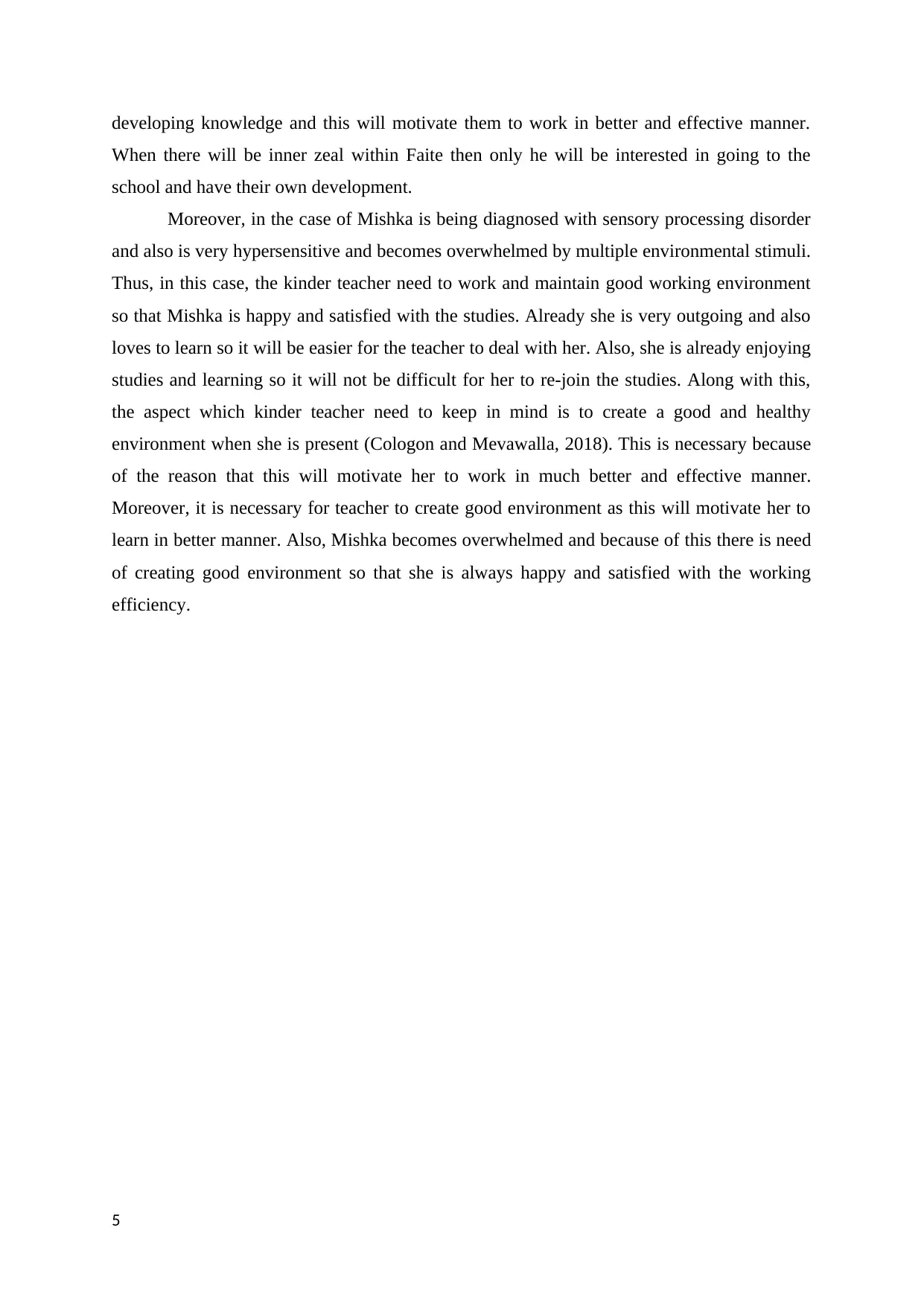
developing knowledge and this will motivate them to work in better and effective manner.
When there will be inner zeal within Faite then only he will be interested in going to the
school and have their own development.
Moreover, in the case of Mishka is being diagnosed with sensory processing disorder
and also is very hypersensitive and becomes overwhelmed by multiple environmental stimuli.
Thus, in this case, the kinder teacher need to work and maintain good working environment
so that Mishka is happy and satisfied with the studies. Already she is very outgoing and also
loves to learn so it will be easier for the teacher to deal with her. Also, she is already enjoying
studies and learning so it will not be difficult for her to re-join the studies. Along with this,
the aspect which kinder teacher need to keep in mind is to create a good and healthy
environment when she is present (Cologon and Mevawalla, 2018). This is necessary because
of the reason that this will motivate her to work in much better and effective manner.
Moreover, it is necessary for teacher to create good environment as this will motivate her to
learn in better manner. Also, Mishka becomes overwhelmed and because of this there is need
of creating good environment so that she is always happy and satisfied with the working
efficiency.
5
When there will be inner zeal within Faite then only he will be interested in going to the
school and have their own development.
Moreover, in the case of Mishka is being diagnosed with sensory processing disorder
and also is very hypersensitive and becomes overwhelmed by multiple environmental stimuli.
Thus, in this case, the kinder teacher need to work and maintain good working environment
so that Mishka is happy and satisfied with the studies. Already she is very outgoing and also
loves to learn so it will be easier for the teacher to deal with her. Also, she is already enjoying
studies and learning so it will not be difficult for her to re-join the studies. Along with this,
the aspect which kinder teacher need to keep in mind is to create a good and healthy
environment when she is present (Cologon and Mevawalla, 2018). This is necessary because
of the reason that this will motivate her to work in much better and effective manner.
Moreover, it is necessary for teacher to create good environment as this will motivate her to
learn in better manner. Also, Mishka becomes overwhelmed and because of this there is need
of creating good environment so that she is always happy and satisfied with the working
efficiency.
5
Paraphrase This Document
Need a fresh take? Get an instant paraphrase of this document with our AI Paraphraser
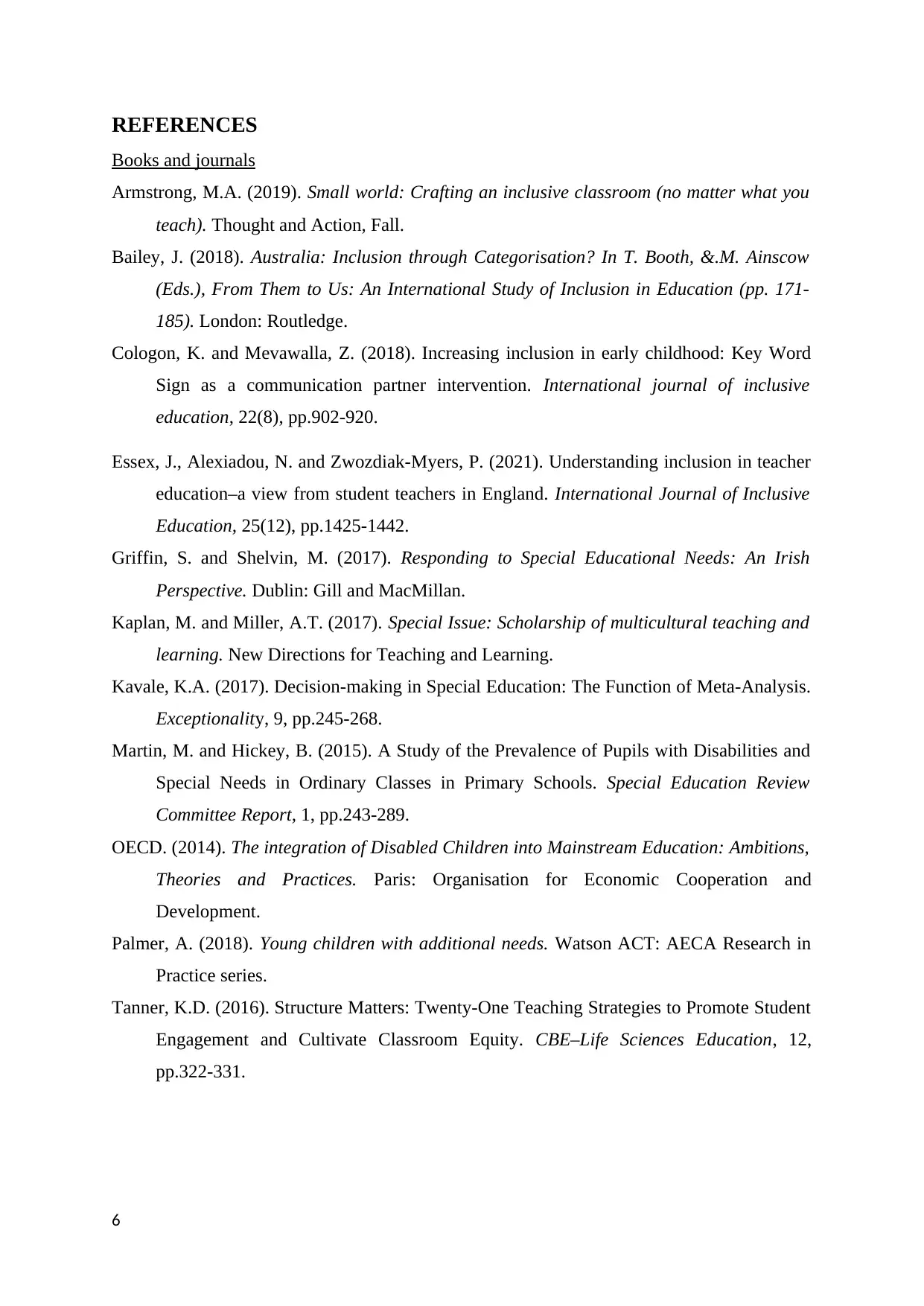
REFERENCES
Books and journals
Armstrong, M.A. (2019). Small world: Crafting an inclusive classroom (no matter what you
teach). Thought and Action, Fall.
Bailey, J. (2018). Australia: Inclusion through Categorisation? In T. Booth, &.M. Ainscow
(Eds.), From Them to Us: An International Study of Inclusion in Education (pp. 171-
185). London: Routledge.
Cologon, K. and Mevawalla, Z. (2018). Increasing inclusion in early childhood: Key Word
Sign as a communication partner intervention. International journal of inclusive
education, 22(8), pp.902-920.
Essex, J., Alexiadou, N. and Zwozdiak-Myers, P. (2021). Understanding inclusion in teacher
education–a view from student teachers in England. International Journal of Inclusive
Education, 25(12), pp.1425-1442.
Griffin, S. and Shelvin, M. (2017). Responding to Special Educational Needs: An Irish
Perspective. Dublin: Gill and MacMillan.
Kaplan, M. and Miller, A.T. (2017). Special Issue: Scholarship of multicultural teaching and
learning. New Directions for Teaching and Learning.
Kavale, K.A. (2017). Decision-making in Special Education: The Function of Meta-Analysis.
Exceptionality, 9, pp.245-268.
Martin, M. and Hickey, B. (2015). A Study of the Prevalence of Pupils with Disabilities and
Special Needs in Ordinary Classes in Primary Schools. Special Education Review
Committee Report, 1, pp.243-289.
OECD. (2014). The integration of Disabled Children into Mainstream Education: Ambitions,
Theories and Practices. Paris: Organisation for Economic Cooperation and
Development.
Palmer, A. (2018). Young children with additional needs. Watson ACT: AECA Research in
Practice series.
Tanner, K.D. (2016). Structure Matters: Twenty-One Teaching Strategies to Promote Student
Engagement and Cultivate Classroom Equity. CBE–Life Sciences Education, 12,
pp.322-331.
6
Books and journals
Armstrong, M.A. (2019). Small world: Crafting an inclusive classroom (no matter what you
teach). Thought and Action, Fall.
Bailey, J. (2018). Australia: Inclusion through Categorisation? In T. Booth, &.M. Ainscow
(Eds.), From Them to Us: An International Study of Inclusion in Education (pp. 171-
185). London: Routledge.
Cologon, K. and Mevawalla, Z. (2018). Increasing inclusion in early childhood: Key Word
Sign as a communication partner intervention. International journal of inclusive
education, 22(8), pp.902-920.
Essex, J., Alexiadou, N. and Zwozdiak-Myers, P. (2021). Understanding inclusion in teacher
education–a view from student teachers in England. International Journal of Inclusive
Education, 25(12), pp.1425-1442.
Griffin, S. and Shelvin, M. (2017). Responding to Special Educational Needs: An Irish
Perspective. Dublin: Gill and MacMillan.
Kaplan, M. and Miller, A.T. (2017). Special Issue: Scholarship of multicultural teaching and
learning. New Directions for Teaching and Learning.
Kavale, K.A. (2017). Decision-making in Special Education: The Function of Meta-Analysis.
Exceptionality, 9, pp.245-268.
Martin, M. and Hickey, B. (2015). A Study of the Prevalence of Pupils with Disabilities and
Special Needs in Ordinary Classes in Primary Schools. Special Education Review
Committee Report, 1, pp.243-289.
OECD. (2014). The integration of Disabled Children into Mainstream Education: Ambitions,
Theories and Practices. Paris: Organisation for Economic Cooperation and
Development.
Palmer, A. (2018). Young children with additional needs. Watson ACT: AECA Research in
Practice series.
Tanner, K.D. (2016). Structure Matters: Twenty-One Teaching Strategies to Promote Student
Engagement and Cultivate Classroom Equity. CBE–Life Sciences Education, 12,
pp.322-331.
6
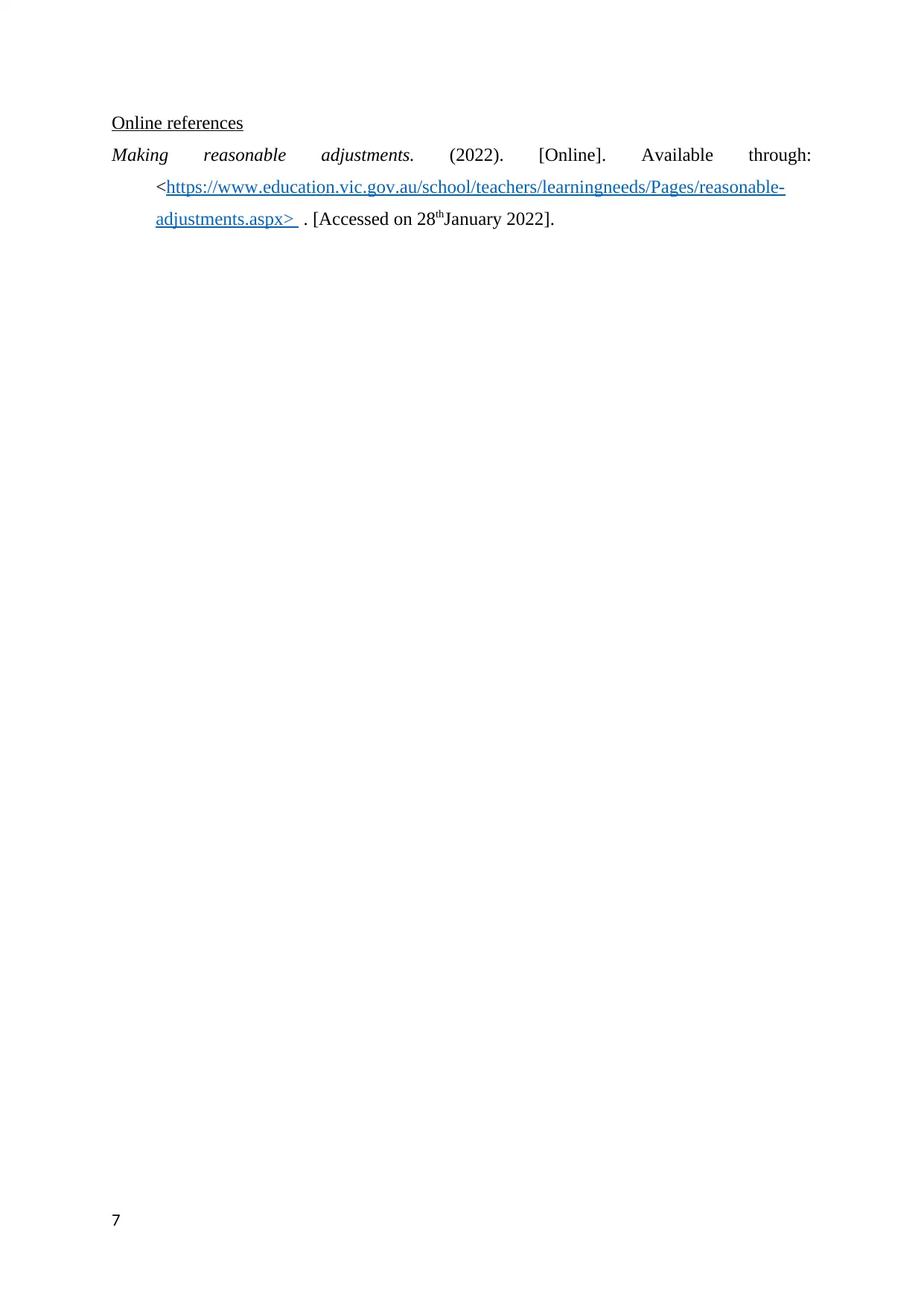
Online references
Making reasonable adjustments. (2022). [Online]. Available through:
<https://www.education.vic.gov.au/school/teachers/learningneeds/Pages/reasonable-
adjustments.aspx> . [Accessed on 28thJanuary 2022].
7
Making reasonable adjustments. (2022). [Online]. Available through:
<https://www.education.vic.gov.au/school/teachers/learningneeds/Pages/reasonable-
adjustments.aspx> . [Accessed on 28thJanuary 2022].
7
⊘ This is a preview!⊘
Do you want full access?
Subscribe today to unlock all pages.

Trusted by 1+ million students worldwide
1 out of 9
Related Documents
Your All-in-One AI-Powered Toolkit for Academic Success.
+13062052269
info@desklib.com
Available 24*7 on WhatsApp / Email
![[object Object]](/_next/static/media/star-bottom.7253800d.svg)
Unlock your academic potential
Copyright © 2020–2025 A2Z Services. All Rights Reserved. Developed and managed by ZUCOL.





